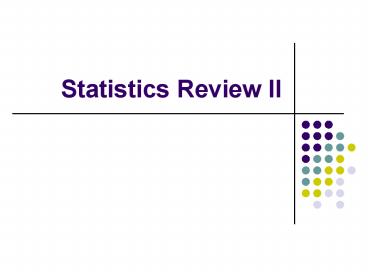Statistics Review II - PowerPoint PPT Presentation
1 / 12
Title:
Statistics Review II
Description:
Engagement Ring Example: ... Mean cost of an engagement ring is $500, and the standard deviation is $100. ... the trip's price into a ring price using z-scores. ... – PowerPoint PPT presentation
Number of Views:49
Avg rating:3.0/5.0
Title: Statistics Review II
1
Statistics Review II
2
Empirical Rule
- Many naturally occurring variables have
bell-shaped distributions. That is, their
histograms take a symmetrical and unimodal shape. - When this is true, you can be sure that the
empirical rule will hold. - Empirical rule If the histogram of data is
approximately bell-shaped, then - About 68 of the cases fall between Y-bar s.d.
and Y-bar s.d. - About 95 of the data fall between Y-bar 2s.d.
and Y-bar 2s.d. - All or nearly all the data fall between Y-bar
3s.d. and Y-bar 3s.d.
3
Empirical Rule
- Empirical rule If the histogram of data is
approximately bell-shaped, then - About 68 of the cases fall between Y-bar s.d.
and Y-bar s.d. - About 95 of the cases fall between Y-bar 2s.d.
and Y-bar 2s.d. - All or nearly all the cases fall between Y-bar
3s.d. and Y-bar 3s.d.
Body Pile 100 of Cases
s.d.
15
15
15
s.d.
15
M 100 s.d. 15
85
55
70
115
130
145
or 1 s.d.
or 2 s.d.
or 3 s.d.
4
Normal Curve
- The Normal Probability Distribution
- A continuous probability distribution in which
the horizontal axis represents all possible
values of a variable and the vertical axis
represents the probability of those values
occurring. Values are clustered around the mean
in a symmetrical, unimodal pattern known as the
bell-shaped curve or normal curve.
5
Normal Curve
- The Normal Probability Distribution
- No matter what the actual s.d. (?) value is, the
- proportion of cases under the curve that
corresponds - with the mean (?)/- 1s.d. is the same (68).
- The same is true of mean/- 2s.d. (?95)
- And mean /- 3s.d. (almost all cases)
- Because of the equivalence of all
- Normal Distributions, these are often
- described in terms of the Standard Normal Curve
- where mean 0 and s.d. 1 and is called z
6
Normal Curve
- The Normal Probability Distribution
- No matter what the actual s.d. (?) value is, the
- proportion of cases under the curve that
corresponds - with the mean (?)/- 1s.d. is the same (68).
- The same is true of mean/- 2s.d. (?95)
- And mean /- 3s.d. (almost all cases)
- Because of the equivalence of all
- Normal Distributions, these are often
- described in terms of the Standard Normal Curve
- where mean 0 and s.d. 1 and is called z
- Z of standard deviations away from the mean
68
68
Z -3 -2 -1 0 1 2 3
Z-3 -2 -1 0 1 2 3
7
Normal Curve
- Converting to z-scores
- To compare different normal curves, it is helpful
to know how to convert data values into z-scores. - It is like have two rulers beneath each normal
curve. One for data values, the second for
z-scores.
IQ ? 100 ? 15
Values 55 70 85 100 115 130
145
Z-scores -3 -2 -1 0 1
2 3
8
Normal Curve
- Converting to z-scores
- Z Y ?
- ?
Z 100 100 / 15 0 Z 145 100 / 15 45/15
3 Z 70 100 / 15 -30/15 -2 Z 105 100
/ 15 5/15 .33
IQ ? 100 ? 15
Values 55 70 85 100 115 130
145
Z-scores -3 -2 -1 0 1
2 3
9
Normal Curve
- Engagement Ring Example
- Mean cost of an engagement ring is 500, and the
standard deviation is 100. - Z Y ?
- ?
Z 500 500 / 100 0 Z 600 500 / 100
100/100 1 Z 200 500 / 100 -300/100 -3 Z
550 500 / 100 50/100 .5
Ring ? 100 ? 15
Values 200 300 400 500 600 700
800
Z-scores -3 -2 -1 0 1
2 3
10
Normal Curve
- Engagement Ring Example
- Mean cost of an engagement ring is 500, and the
standard deviation is 100.
Now, use the empirical rule What percentage of
people will be above or below my preferred ring
price of 300?
Ring ? 100 ? 15
2.5
2.5
68
Values 200 300 400 500 600 700
800
Z-scores -3 -2 -1 0 1
2 3
11
Normal Curve
- Comparing two distributions by Z-score
- Imagine that your partner didnt get you a ring,
but took you on a trip to express their love for
you. You could convert the trips price into a
ring price using z-scores. - Your trip cost 2,000. The average love trip
costs 1,500 with a s.d. of 250. What is the
equivalent ring price?
Trips
Rings
200 300 400 500 600 700 800
750 1000 1250 1500 1750 2000 2250
-3 -2 -1 0 1 2
3
-3 -2 -1 0 1 2
3
12
Normal Curve
- Comparing two distributions by Z-score
- Your trip cost 2,000. The average love trip
costs 1,500 with a s.d. of 250. What is the
equivalent ring price? - What percentage of persons got a trip that cost
less than yours?
Trips
Rings
200 300 400 500 600 700 800
750 1000 1250 1500 1750 2000 2250
-3 -2 -1 0 1 2
3
-3 -2 -1 0 1 2
3































